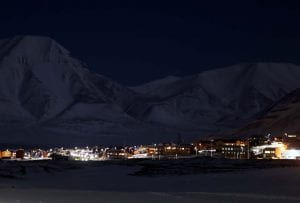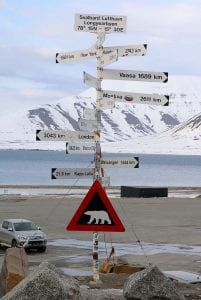Could Arctic disasters create diplomacy?
By Saqar ' M Al Zaabi, on 12 June 2019
Post written by Patrizia Isabelle Duda, PhD researcher at UCL IRDR
Fancy lodgings with outdoor Jacuzzis, brand-name clothing outlets, a Thai massage centre, restaurants offering haute cuisine, a supermarket that displays all manner of fresh food and electronics items—one would have thought that I landed in a First World urban setting. But the Norwegian-governed settlement of Longyearbyen on the Arctic Svalbard archipelago is anything but that.

Longyearbyen’s main street with fancy restaurants and hotels during Svalbard’s dark winter season – Copyright Patrizia Isabelle Duda 2019
Rather, it is a small settlement north of the Arctic Circle, the size of a thumbprint viewed from on high – plunked down in the midst of a valley, surrounded by mountain ranges and a vast road-less expanse of rock, snow, and glacial ice that is prone to avalanches, landslides, flooding and extreme weather conditions. The archipelago is roamed by polar bears, geographically isolated from the Norwegian mainland that governs it (it is halfway between Norway and the North Pole), and reliant on good weather conditions to access it. Thus, Svalbard is especially vulnerable to disasters, from which response mechanisms, no matter how well planned, may not always deliver.

A photo of Longyearbyen taken on a winter climb to a mountain top nearby in -47 °C – Copyright Patrizia Isabelle Duda 2019
As far as disasters go, there is a gamut of factors besides its remote location and its dicey weather that impinge on Svalbard’s ability to respond. A lack of communication between its settlements is problematic. Its possible overreliance on national response structures which must both be able to react with adequate resources within narrow time frames, as well as have the political will to do so, further compounds the precarious situation. In addition, the present restricted ability of Svalbard’s small hospital to treat more than minor-level injuries, necessitates an over-reliance on aeromedical evacuation to the mainland. Thus, the capacity for major trauma scenarios is missing.
Given both the existing gaps as well as clear developing and future challenges, it is critical that we take stock of Svalbard’s emergency preparedness and response capacity and develop robust policies that are adapted to the local realities on the island. This means that not only search-and-rescue capacities are needed, which it seems Svalbard has well understood (albeit these are and can only be imperfect); but that improved governance on a much wider scale is urgently required. It must be remembered that disaster efforts do not always happen formally. Both when formal disaster efforts fail, but also when they do not, informality is often a key element of disaster preparedness and response. In Svalbard’s particular case, this means cooperation and coordination between the two main players on the island—formally, Norway and Russia, and informally, Norwegians and Russians—for efforts both to prevent disasters, as well as to address them when they happen.
These are the questions I pondered together with a team of nine researchers from London, Moscow and around Norway who assembled in Longyearbyen to launch our new project. Generously funded by the Norwegian Research Council, we initiated a 2-year investigation into disaster diplomacy’s potential to foster cooperation (or not) between Svalbard’s Norwegian and Russian stakeholders in their formal and informal responses to disasters. To this end, the project will be looking at three hypothetical disaster scenarios: an oil spill emergency, a crisis involving radiation release from a ship, and a disease outbreak in (Russian) Barentsburg—the second of the only two permanently inhabited settlements on Svalbard.
The importance of this project is startingly clear. Moving on from its early days as a coal-mining settlement, Svalbard is now home (albeit a transient one) to a growing population of scientists and tourists. Moreover, this group of islands is currently being re-imagined and re-developed into an Arctic Ocean emergency management hub. This new hub will act like a magnet, drawing yet more scientists, tourists and job-seekers to an island of roughly 2600 inhabitants, requiring quickly built new infrastructure to support these activities. Coupled with the effects of the already changing environment, Svalbard’s vulnerable settlements, not to mention, the whole region and its ecosystems, are further at risk.
Additionally, some fear that it may also spark a new round of disputes and conflicts between Norway and Russia, (and looking out on the broader horizon, between other nations that have stakes in the Arctic region). Transnational cooperation will be more crucial than ever in tackling the already compromised possible disaster responses. Thus, from a different perspective, this emerging reality might, at least in theory, pave the way for greater diplomatic and practical collaboration on disaster issues and may, by extension, improve many aspects of relations between these two countries that share vested interests in Svalbard.
It is clear from research on disaster diplomacy in other global settings that this second idealistic and much more hopeful perspective is not supported by actual results. Disaster diplomacy has not yet been shown to lead to better relations between countries. But can these findings be applied to Svalbard, and to the Arctic in general, an area which is held to be ‘off the charts’ in so many spheres? As researchers, we hear the often-recited mantra that Arctic players have already come up with uniquely successful and often unprecedented cooperation schemes. Thus, could the Arctic prove to be an exception in the universe of unsuccessful disaster diplomacy case studies? And might the various factors that were present in the particular Arctic situation be extrapolated and applied in disaster conditions elsewhere in the world?
I ask myself these questions, as I gaze out past the high-end stores and entertainment centres, to the beautiful but forbidding mountain range just behind them, looking off into the polar-night sky. Svalbard is fragile, vulnerable to disaster, and may well become even more exposed to danger. But might it not also hold the seeds to plant future opportunities for cooperation and improvement in international relations? Or, will the research results elsewhere in the world be confirmed? Our team hopes that our research will be able to begin to answer some of these questions.
 Close
Close




